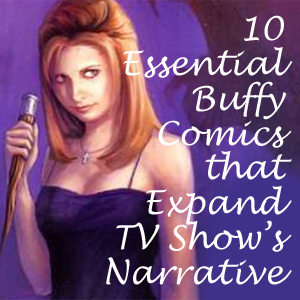Perhaps you’re a fan of the “Buffy” TV series or the TV-series-plus-the-current-comics who is thinking of tip-toeing into the canonically muddy waters of the old Dark Horse comics, from 1998-2004. There is a ton of good stuff (and some not-so-good stuff) to weed through, but maybe you want to cut to the chase. Which stories tie in most closely with the TV series? Which ones enhance the narrative? In short: Which ones are essential?
Well, arguably, none are essential. After all, you can watch from “Welcome to the Hellmouth” to “Chosen” without missing anything crucial. However, there are plenty of comics – some written by scribes from the TV staff – that give fuller insights and occasionally even new insights into Buffy and her friends.
Those are the stories I’ve listed here. It’s not strictly a best-of list, although many of the elite stories from Dark Horse’s original run can be found here. To help you follow the continuity, I’ve positioned them on the “Buffy” timeline with “episode” numbers.
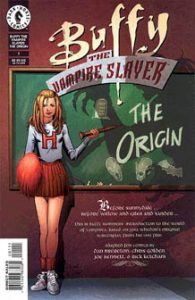
“The Origin”
“Season 0, episode 1”
If you caught the “Welcome to the Hellmouth” (1.1) reference to Buffy burning down her previous school’s gym and thought “I don’t remember that from the movie,” you need to read “The Origin” – the most essential comic from Dark Horse’s original stint and an ideal entry point to “Buffy” readership. Adapted by Christopher Golden, “The Origin” takes Joss Whedon’s film script, subtracts the movie’s campy direction, and combines it with the likenesses of Sarah Michelle Gellar and Richard Riehle (TV’s Merrick). Whedon was often chilly toward Dark Horse’s early work, but even he said: “The origin comic can pretty much be accepted as canonical.” (Full review)

“Viva Las Buffy!”
“Season 0, episode 2”
At the end of the 1992 movie (and “The Origin”), Buffy and Pike head to Las Vegas, portending a sequel. In 2002, Scott Lobdell and Fabian Nicieza finally told this tale. A surprisingly grim story considering the vibrant title, “Viva Las Buffy!” is an excellent portrayal of how Buffy takes out her frustrations with the very powers she is depressed about having. The events unfold through the eyes of Pike, who is the anti-Xander: Thinking he’s a burden to the Slayer, he departs. (Full review)
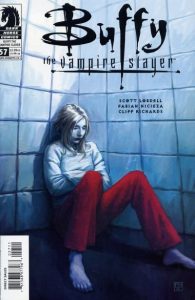
“Slayer, Interrupted”
“Season 0, episode 3”
In this tie-in to “Normal Again” (6.17), we see Buffy’s time in the mental institution. Similar to “Anne” (3.1), she tries to dodge her calling, but she’s dragged into saving the day and actually feels OK about it. The seeming plot hole of the Watchers’ Council leaving Buffy unattended between Merrick and Giles is addressed in two ways: An ex-Watcher is keeping tabs on Buffy at the hospital, and Giles – owing to his checkered past — must pass trials before being approved as the Watcher of the active Slayer. (Full review)
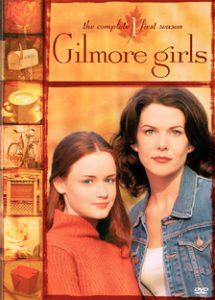
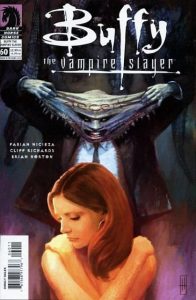
“A Stake to the Heart”
“Season 0, episode 4”
There are “Slayer stories” and there are “Buffy stories,” and this is the latter. After somewhat coming to terms with being the Slayer, Buffy now faces her parents’ divorce, which in classic kid fashion, she think is her fault. Her guilt, plus the trepidation of moving to Sunnydale with her mom and Dawn, take the form of demons in this stylized tale. The demons are released by a stalker-mode Angel, who messes up in his attempt to alleviate Buffy’s pain with a spell. (Full review)
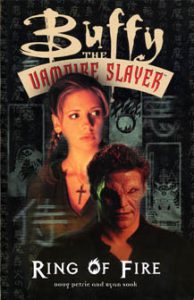
“Ring of Fire”
Season 2, “episode 18.5”
Doug Petrie’s “lost episode” from the Angelus arc takes place partway between “Passion” (2.17), when Giles nearly gets himself killed by challenging Angelus, and “Becoming, Part 1” (2.21). Giles again gets reckless, and Buffy seeks assurance that he hasn’t relapsed, but he is more composed than before. Ryan Sook’s art perfectly captures the evil of Angelus, and Petrie ramps up Kendra’s confidence and Buffy’s sword-fighting skills. (Full review)
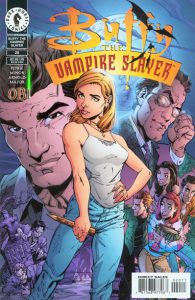
“Double Cross”
Season 3, “episode 23”
Season 4 had a grace note with “Restless” (4.22), so why didn’t Season 3 get one? Well, it actually got two, both in comic-book form. In this Petrie yarn, a demon tries to take advantage of Buffy and Angel’s bond, and their mutual (if unhappy) belief that they must go their separate ways gets further underscored. (Full review)
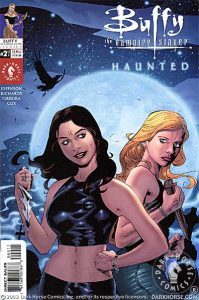
“Haunted”
Season 3, “episode 24”
An even better coda to Season 3 is this series by Jane Espenson. Buffy is going through PTSD after leading the defensive war to save her graduating class from the demon Mayor. She is particularly haunted by nearly killing Faith. That makes this a bridge story to “This Year’s Girl” (4.15), of course, but in an ingenious twist, the Mayor provides another link to Season 4. Having taken the form of a vampire, he kills the Initiative soldier Adam, who will later be resurrected as the next Big Bad. (Full review)
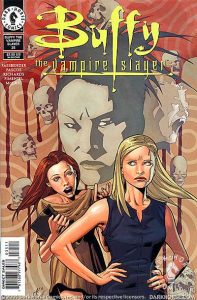
“False Memories”
Season 5, “episode 14.5”
Writers Tom Fassbender and Jim Pascoe address that wiggy feeling viewers had in Season 5 wherein we know Dawn hasn’t always existed, but the Scoobies think she has. In a storytelling trick reminiscent of “Normal Again,” Buffy gains access to memories of a reality without Dawn. Buffy making this psychological adjustment is a nice, sympathetic nod toward fans. (Full review)
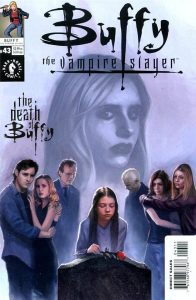
“The Death of Buffy”
Season 5, “episode 23”
Buffy dies at the end of Season 5, then Willow brings her back with magic at the start of Season 6 – after a summer where our heroes successfully fool the populace into thinking Buffy is alive and well. Obviously, there are logistics to be ironed out, and Fassbender and Pascoe tackle some plot holes. Others remain; for example, how does Buffy simultaneously have a tombstone and a presence in the community? Still, “The Death of Buffy” portrays how everyone is uncertain about Willow’s plan, and we see Dawn at a heartbreakingly low ebb. (Full review)
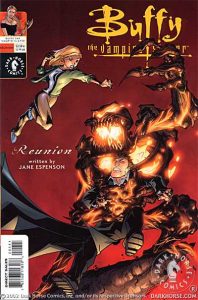
“Reunion”
Season 6, “episode 4.5”
I hesitated to put this one-shot on the list, because it’s a fake-out: Espenson purports to tell of Buffy’s meeting with Angel after “Flooded” (6.4), but she instead gives us Dawn, Xander and Anya playing guessing games about the reunion. Still, it fits with the tone of early Season 6, when life is hard but at least Buffy is not dead anymore. The fact that everyone’s guesses are wrong illustrates how out of touch they are with Buffy during this time. (Full review)
Click here for an index of all of John’s “Buffy” and “Angel” reviews.

